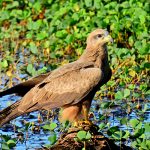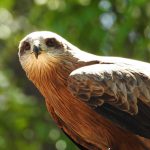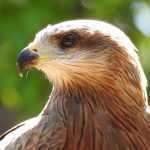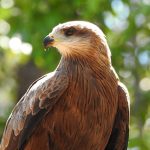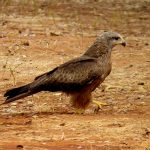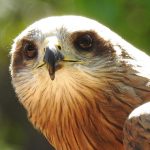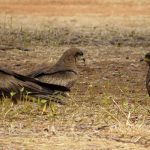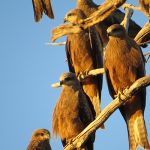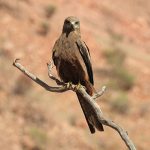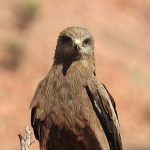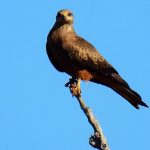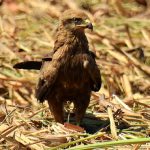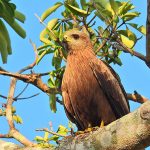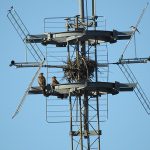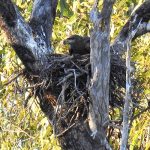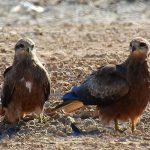BLACK KITE
The Soaring Opportunist
Amidst the vast skies of Australia, a winged silhouette often spirals high above, gliding with effortless grace. This is the Black Kite, a bird whose adaptability and keen intelligence have allowed it to become one of Australia’s most widespread raptors. Let us journey into the daily life of the Black Kite, exploring its remarkable abilities and the subtle role it plays in both wild and urban ecosystems.
Physical Features
- Size: Medium-sized with a wingspan stretching from 150 to 160 centimetres.
- Length: Approximately 50–60 centimetres from beak to tail.
- Distinctive Markings:
- Forked tail: Shaped like an open V, especially distinct in flight.
- Dark plumage: Almost black from a distance, with lighter feathers accenting the head and underparts.
- Eyes and Beak: Keen, piercing eyes and a sharply hooked beak, perfectly adapted for hunting and scavenging.
Senses Brought to Life
Imagine standing in a sunlit field as you hear the call of the Black Kite—sharp and whistling, cutting through the air. Watch as it wheels overhead, its dark silhouette moving silently against the blue, every wingbeat precise and assured. If you were close enough, you might catch the faint musty scent of feathers, warmed by the sun.
| Habitat Type | Description |
|---|---|
| Open Woodlands | Tall trees, scattered shade, perfect for nesting. |
| Grasslands | Wide open spaces, hunting made easy. |
| Wetlands | Abundant food sources, especially near water. |
| Farmlands | Rodents and insects drawn to crops. |
| Urban Areas | Thriving near people, scavenging opportunities abound. |
Note: The Black Kite is absent from the densest rainforests and the heart of true deserts, thriving instead in environments where resources and open airspace are plentiful.
Feeding Habits
Black Kites are opportunistic feeders. Their diet changes depending on what is available:
- Small mammals: Mice, rats, and occasionally even rabbits.
- Other birds: Especially nestlings or injured individuals.
- Insects: Particularly abundant during swarming events.
- Carrion: Feeding on animal remains, including roadkill and scraps.
In urban settings, they are often seen gliding above streets and rubbish tips, gracefully swooping down to pick up discarded food. Their presence helps manage waste and reduces the spread of disease, quietly performing a public service.
The Art of Flight
The Black Kite is a vision of elegance in the air:
- Soaring: Rising on thermal currents, the kite circles almost without effort, its wings held in a shallow ‘V’.
- Agility: It can wheel and dive suddenly when prey is spotted, its movements swift and purposeful.
- Social behaviour: Often found in loose groups, particularly where food is plentiful.
You might witness a gathering of kites high above, riding invisible updrafts—silent dancers in a sky-wide ballet.
Life Cycle and Nesting
| Stage | Detail |
|---|---|
| Nesting | Built in tall trees using sticks and leaves, often close to rivers or wetlands. |
| Eggs | Typically 2–4 eggs per clutch. |
| Parental Care | Both parents share the duties of incubation and feeding the chicks. |
| Chicks | Grow rapidly, fledging within a few weeks as they prepare for a life on the wing. |
Migration & Resident Populations
- Migratory in some regions: Moving in response to changing seasons and food supplies, following the bounty.
- Largely sedentary in others: Remaining year-round where conditions are favourable.
Conservation Connection
Though widespread and often seen in proximity to humans, the Black Kite’s story is a subtle reminder of the interconnectedness of city and wilderness. As scavengers, they help keep environments clean, supporting the health of ecosystems.
It is important to remember:
- Protecting their nesting sites, especially large old-growth trees, safeguards future generations.
- Reducing pollutants and litter makes environments safer for birds and people alike.
The Resilient Raptor
Picture a dusk sky over inland Australia— air cool, gum trees silhouetted, and a swarm of Black Kites folding their wings against the breeze, heading to their roosts. Each bird is a testament to adaptability and the often unseen, vital work that nature’s opportunists provide.
The next time you see a Black Kite circling overhead, know that this elegant raptor is not just surviving—it is playing a key role in Australia’s diverse and ever-changing landscapes.
Quick Facts Table
| Trait | Description |
|---|---|
| Wingspan | 150–160 cm |
| Length | 50–60 cm |
| Tail Shape | Distinctive forked tail |
| Diet | Small mammals, birds, insects, carrion, urban scraps |
| Habitat | Woodlands, grasslands, wetlands, farmlands, urban areas |
| Conservation | Not threatened; plays a key ecological ‘clean-up’ role |
Protecting creatures like the Black Kite is protecting the texture and balance of Australia’s living landscapes. Every wingbeat in our skies carries a lesson in resilience and harmony.

